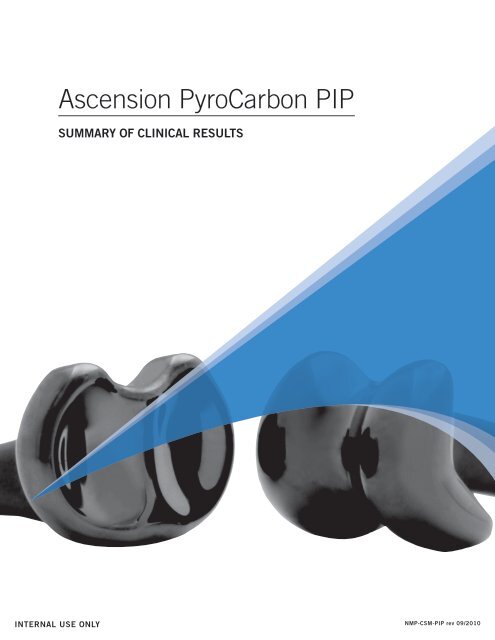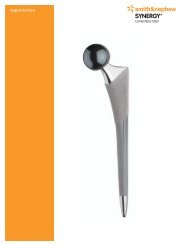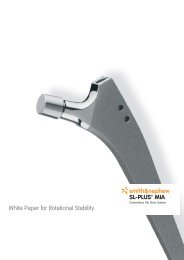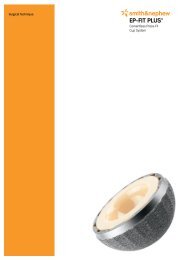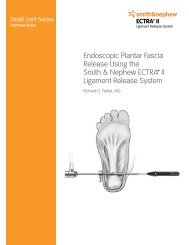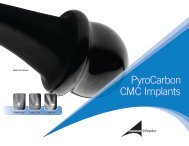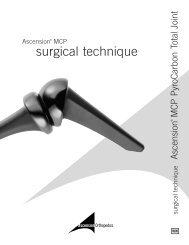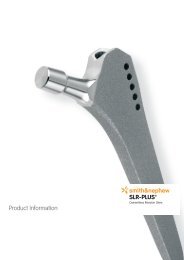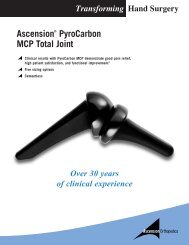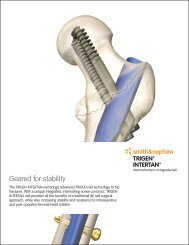Proximal interphalangeal Joint arthroplasty
Proximal interphalangeal Joint arthroplasty
Proximal interphalangeal Joint arthroplasty
Create successful ePaper yourself
Turn your PDF publications into a flip-book with our unique Google optimized e-Paper software.
Ascension PyroCarbon PIP<br />
summary of clinical Results<br />
INTERNAL USE ONLY NMP-CSM-PIP rev 09/2010
Overview of PyroCarbon PIP Clinical Results<br />
Overview of PyroCarbon PIP<br />
Clinical Results<br />
PYC PIP<br />
Table of Contents<br />
Summary .....................................................................................................1<br />
Review of PyroCarbon PIP Clinical Results<br />
Long-Term Evaluation of Pyrolytic Carbon Implant Arthroplasty in the <strong>Proximal</strong> Interphalangeal <strong>Joint</strong> of the Hand (Abstract) ....... 2<br />
Outcomes of <strong>Proximal</strong> Interphalangeal <strong>Joint</strong> PyroCarbon Implants.......................................................3<br />
Outcomes of Pyrolytic Carbon Arthroplasty for the <strong>Proximal</strong> Interphalangeal <strong>Joint</strong> ..........................................4<br />
Pyrolytic Carbon <strong>Proximal</strong> Interphalangeal <strong>Joint</strong> Arthroplasty: Results with Minimum Two-Year Follow-Up Evaluation.............5<br />
Resurfacing Arthroplasty versus Silicone Arthroplasty for <strong>Proximal</strong> Interphalangeal <strong>Joint</strong> Osteoarthritis .........................6<br />
<strong>Proximal</strong> Interphalangeal <strong>Joint</strong> Replacement with Pyrolytic Carbon Prostheses .............................................7<br />
Pyrolytic Carbon <strong>Proximal</strong> Interphalangeal <strong>Joint</strong> Resurfacing Arthroplasty.................................................8<br />
Pyrolytic Carbon Arthroplasty for Posttraumatic Arthritis of the <strong>Proximal</strong> Interphalangeal <strong>Joint</strong>................................9<br />
Problematic Bone Fixation with Pyrocarbon Implants in <strong>Proximal</strong> Interphalangeal <strong>Joint</strong> Replacement: Short-Term Results......... 10<br />
Case Reports<br />
Intraoperative Fracture of a Pyrocarbon PIP Total <strong>Joint</strong> – A Case Report ............................................... 11<br />
Creation of Four-<strong>Joint</strong>-Digit after Second Toe to Digit Transplantation: Restoration of Form and Function.. . . . . . . . . . . . . . . . . . . 11<br />
Surgical Techniques and Postoperative Therapy<br />
Postoperative Management for PIP <strong>Joint</strong> Pyrocarbon Arthroplasty ................................................. 12<br />
The Volar Approach to <strong>Proximal</strong> Interphalangeal <strong>Joint</strong> Arthroplasty. ............................................... 12<br />
New <strong>Joint</strong> Replacements of the Hand and Wrist................................................................ 12<br />
PIP and MCP <strong>Joint</strong> Arthroplasty ........................................................................... 13<br />
<strong>Proximal</strong> Interphalangeal <strong>Joint</strong> Arthroplasty................................................................... 13<br />
Competitive Studies<br />
Cemented Versus Uncemented Surface Replacement Arthroplasty of the <strong>Proximal</strong> Interphalangeal <strong>Joint</strong> with a<br />
Mean 5-Year Follow-Up................................................................................ 14<br />
Surface Replacement Arthroplasty of the <strong>Proximal</strong> Interphalangeal <strong>Joint</strong> Using the PIP-SRA Implant: Results,<br />
Complications, and Revisions............................................................................ 15<br />
Development of a Surface Replacement Arthroplasty for <strong>Proximal</strong> Interphalangeal <strong>Joint</strong>s ............................... 16<br />
Bibliography ................................................................................................ 17<br />
INTERNAL USE ONLY<br />
INTERNAL USE ONLY
Overview of PyroCarbon PIP Clinical Results<br />
Summary<br />
Title of Report Citation Eval. Group Follow-Up Evaluation Result According to Authors<br />
Long-term Evaluation of the Pyrolytic<br />
Carbon Implant Arthroplasty in the<br />
<strong>Proximal</strong> Interphalangeal <strong>Joint</strong> of the<br />
Hand (Abstract)<br />
Outcomes of <strong>Proximal</strong> Interphalangeal<br />
<strong>Joint</strong> PyroCarbon Implants<br />
Hsu et al.,<br />
2010<br />
Wijk et al,<br />
2010<br />
164 joints,<br />
107 patients<br />
53 joints,<br />
43 patients<br />
Mean<br />
23.6 months<br />
Minimum<br />
1 year, mean<br />
23 months<br />
ROM, pain,<br />
grip strength<br />
Pain, ROM,<br />
grip strength,<br />
DASH, COPM<br />
ROM increased, grip strength<br />
increased, pain relief was present<br />
in 84.1% of patients who received<br />
implant<br />
Decreased pain in all patients,<br />
increase in ROM, improved grip<br />
strength, DASH score and COPM<br />
PYC PIP<br />
Outcomes of Pyrolytic Carbon<br />
Arthroplasty for the <strong>Proximal</strong><br />
Interphalangeal <strong>Joint</strong><br />
Chung et al.,<br />
2009<br />
21 joints,<br />
14 patients<br />
Taken<br />
preoperatively,<br />
3, 6, and<br />
12 months<br />
postoperatively<br />
Arc of motion, grip<br />
and pinch strength,<br />
Michigan hand score<br />
Improvement of grip and pinch<br />
strength, excellent pain relief, high<br />
patient satisfaction<br />
Pyrolytic Carbon <strong>Proximal</strong><br />
Interphalangeal <strong>Joint</strong> Arthroplasty:<br />
Results with Minimum Two-Year<br />
Follow-Up Evaluation<br />
Bravo et al.,<br />
2007<br />
50 joints,<br />
35 patients<br />
Mean<br />
27 months<br />
Arc of motion, grip and<br />
pinch strength, pain<br />
Increased arc of motion, improved<br />
grip and pinch strength, pain scores<br />
improved from 6 to 1 (scale, 0-10)<br />
postoperatively<br />
Resurfacing Arthroplasty versus<br />
Silicone Arthroplasty for <strong>Proximal</strong><br />
Interphalangeal <strong>Joint</strong> Osteoarthritis<br />
Brenam et al.,<br />
2007<br />
41 joints,<br />
22 patients<br />
Silicone group:<br />
45 months,<br />
Pyrocarbon<br />
group:<br />
19 months<br />
ROM, grip strength,<br />
patient satisfaction,<br />
appearance<br />
Silicone group had decreased ROM,<br />
1kg increase in grip strength, 6.2 out<br />
of 10 satisfaction score. PyroCarbon<br />
group has increased ROM, 5kg<br />
increase in grip strength, 8.1 out of<br />
10 satisfaction score<br />
<strong>Proximal</strong> Interphalangeal <strong>Joint</strong><br />
Replacement with Pyrolytic Carbon<br />
Prostheses<br />
Meier et al.,<br />
2007<br />
24 joints,<br />
20 patients<br />
Mean<br />
15 months<br />
ROM, pain<br />
Average ROM was 50°, significant<br />
pain relief in all cases<br />
Pyrolytic Carbon <strong>Proximal</strong><br />
Interphalangeal <strong>Joint</strong> Resurfacing<br />
Arthroplasty<br />
Tuttle et al.,<br />
2006<br />
18 joints,<br />
8 patients<br />
Mean<br />
13.7 months<br />
ROM, grip strength,<br />
pain, satisfaction score<br />
Increased grip strength, average<br />
pain score of 1.8 (scale, 1-10), good<br />
patient satisfaction<br />
Pyrolytic Carbon Arthroplasty for<br />
Posttraumatic Arthritis of the <strong>Proximal</strong><br />
Interphalangeal <strong>Joint</strong><br />
Nunley et al.,<br />
2006<br />
7 joints,<br />
5 patients<br />
Mean<br />
17 months<br />
Grip strength,<br />
DASH scores, pain<br />
Grip strength increased from 19kg to<br />
26 kg after surgery, increased DASH<br />
scores, decrease in pain<br />
Problematic Bone Fixation with<br />
PyroCarbon Implants in <strong>Proximal</strong><br />
Interphalangeal <strong>Joint</strong> Replacement:<br />
Short-Term Results<br />
Herren et al.,<br />
2006<br />
17 joints,<br />
14 patients<br />
Mean<br />
19 months<br />
ROM, grip strength,<br />
pain<br />
High patient satisfaction, increased<br />
ROM and grip strength, significant<br />
pain relief for patients<br />
Competitive Studies<br />
Cemented Versus Uncemented Surface<br />
Replacement Arthroplasty for the<br />
<strong>Proximal</strong> Interphalangeal <strong>Joint</strong> with a<br />
Mean 5-Year Follow-Up<br />
Johnstone et al.,<br />
2008<br />
48 Avanta<br />
SR PIP joints,<br />
32 patients<br />
Mean<br />
5 years<br />
Arc of motion,<br />
pain, joint failures,<br />
radiological loosening<br />
Decreased pain score in both groups,<br />
2 joint failures in cemented group, 5<br />
joint failures in uncemented group,<br />
uncemented group had 13 joints with<br />
radiological loosening<br />
Surface Replacement Arthroplasty for<br />
the <strong>Proximal</strong> Interphalangeal <strong>Joint</strong><br />
Using the PIP-SRA Implant: Results,<br />
Complications and Revisions<br />
Jennings et al.,<br />
2008<br />
43 Sbi PIP-SRA<br />
joints,<br />
25 patients<br />
Mean<br />
37 months<br />
Arc of motion,<br />
patient satisfaction,<br />
complications<br />
DIP motion decreased 12°<br />
postoperatively, 12% of patients<br />
were not satisfied with implant, 26%<br />
revision rate<br />
Development of a Surface<br />
Replacement Arthroplasty for <strong>Proximal</strong><br />
Interphalangeal <strong>Joint</strong>s<br />
Linscheid et al.,<br />
1997<br />
66 CrCo and<br />
polyethylene<br />
joints,<br />
47 patients<br />
Mean<br />
4.5 years<br />
ROM, pain,<br />
complications,<br />
secondary operations<br />
ROM increased from 35° to 47°<br />
after surgery, a significant number<br />
of complications occurred, 12<br />
secondary operations were performed<br />
in 11 fingers<br />
INTERNAL USE ONLY<br />
1
Overview of PyroCarbon PIP Clinical Results<br />
CLINICAL report<br />
Long-Term Evaluation of Pyrolytic Carbon Implant Arthroplasty<br />
in the <strong>Proximal</strong> Interphalangeal <strong>Joint</strong> of the Hand<br />
Abstract presented at aahs 2010, boca raton, florida<br />
Chun-Cheng Hsu, Steven Moran, Marco Rizzo, MD, Robert D. Beckenbaugh, MD<br />
PYC PIP<br />
Purpose<br />
The purpose of the study was to retrospectively review long-term outcomes of pyrolytic carbon implant <strong>arthroplasty</strong> of the<br />
proximal <strong>interphalangeal</strong> joint (PIPJ), especially evaluating functional results and complications.<br />
Demographics<br />
• 164 implants in 107 patients<br />
• Indications:<br />
o 54 – osteoarthritis<br />
o 19 – rheumatoid arthritis<br />
o 29 – posttraumatic arthritis<br />
o 5 – psoriatic arthritis<br />
“The pyrolytic carbon implant<br />
for PIPJ <strong>arthroplasty</strong> is effective<br />
in providing pain relief and<br />
better grip power.”<br />
Follow Up<br />
Patients were observed for an average of 23.6 months.<br />
Results<br />
• ROM improved after surgery going from an average of 34.4° preoperatively to 50.4° one year after surgery<br />
• The mean grip power improved from 15.5 Kg preoperatively to 17 Kg one year after surgery<br />
• Pain relief was present in 84.1% of patients who received a PIPJ implant<br />
CONCLUSION<br />
The pyrolytic carbon implant for PIPJ <strong>arthroplasty</strong> is effective is providing pain relief and better grip power. The<br />
active ROM improvement could be encouraged after surgery. However, the potential of gradual active ROM downhill<br />
after 1 year follow up should be concerned.<br />
TABLE 1 Preoperative 3 month 6 month 1 year 2 year 3 year 4 year 5 year 6 year<br />
Number of f/u fingers 167 143 128 95 69 52 24 12 5<br />
Active ROM (°) 34.4 49.0 49.8 50.4 40.4 35.5 42.3 43.9 59.8<br />
Extensor Lag (°) 16.0 23.6 24.4 20.8 21.9 17.1 18.8 12.4 2.6<br />
Compared with<br />
previous f/u (°)<br />
Compared with active<br />
ROM of 3-month f/u (°)<br />
— 14.9 1.4 -2.3 -8.8 -4.2 -2.8 -9.0 8.2<br />
— — 1.4 0.7 -9.7 -14.8 -9.1 -9.8 0.2<br />
Hsu CC, Moran S, Rizzo M, Beckenbaugh R. Long-Term Evaluation of Pyrolytic Carbon Implant Arthroplasty in the <strong>Proximal</strong> Interphalangeal <strong>Joint</strong> of the Hand.<br />
Abstract presented at AAHS 2010, Boca Raton, Florida<br />
2<br />
INTERNAL USE ONLY
Overview of PyroCarbon PIP Clinical Results<br />
CLINICAL report<br />
Outcomes of <strong>Proximal</strong> Interphalangeal <strong>Joint</strong> PyroCarbon Implants<br />
Journal of Hand surgery, January 2010, Vol. 35a<br />
Ulrika Wijk, BS, Margareta Wollmark, BS, Philippe Kopylov, Md, PhD, Magnus Tagil, PhD<br />
Purpose<br />
To prospectively register and report the hand function and occupational performance of patients with proximal <strong>interphalangeal</strong><br />
joint-pyrocarbon <strong>arthroplasty</strong>, using both objective tests and subjective outcome instruments.<br />
Demographics<br />
• 53 joints in 43 patients<br />
• Average age of patient: 59 years old. Range: 40-85 years old<br />
• Indications:<br />
o 28 – Degenerative Osteoarthritis<br />
o 7 – Post Traumatic<br />
o 8 – Rheumatoid Arthritis<br />
“All subjective scores such as<br />
the VAS (pain) at rest and activity,<br />
COPM, and DASH score<br />
improved significantly.”<br />
PYC PIP<br />
Follow Up<br />
Patients were observed for a minimum of 1 year (aevrage 23 months)<br />
Results<br />
• Pain decreased in all patients<br />
• Average patient flexion motion increased from 100° to 138° post operatively<br />
o Average ROM decreased from 15°-100° to 0°-138°<br />
o Each patient was given a slight flexion contracture to avoid hyperextension, which accounts for decrease in hyperextension<br />
• Average grip strength improved from 19Kg to 21kg,<br />
• DASH score improved from a median of 39 to 29<br />
• COPM (patient reported functional outcome measure) improved from 3.8 to 5.9 after surgery<br />
• 13% revision rate<br />
o 7 joints in 7 patients required re-operation: three patients had prosthesis removed due to pain, one patient had<br />
a tenolysis for limited ROM, one RA patient had a postoperative infection with skin necrosis, one patient had a<br />
tenoarthrolysis due to stiffness and extension lag, one patient was re-operated on due to increasing hyperextension<br />
and secondary swan-neck deformity<br />
CONCLUSION<br />
All patients reported decreased pain, and although the authors found no improvement in range of motion and<br />
grip strength, one third of patients reported a clinically significant improvement in occupational performance and<br />
satisfaction. A total of 13% of the joints required a secondary surgical procedure.<br />
Wijk U, Wollmark M, Kopylov P, Tagil M. Outcomes of <strong>Proximal</strong> Interphalangeal <strong>Joint</strong> Pyrocarbon Implants. J Hand Surg 2010; 35A: 38-43<br />
INTERNAL USE ONLY<br />
3
Overview of PyroCarbon PIP Clinical Results<br />
CLINICAL report<br />
Outcomes of Pyrolytic Carbon Arthroplasty for the<br />
<strong>Proximal</strong> Interphalangeal <strong>Joint</strong><br />
plastic and reconstructive surgery, May 2009, volume 123, number 5<br />
Kevin Chung, MD, Ashwin Ram, B.S., Melissa Shauver, M.P.H.<br />
PYC PIP<br />
Purpose<br />
The specific aim of this study was to assess outcomes and complication rates of a consecutive series<br />
of patients undergoing proximal <strong>interphalangeal</strong> joint <strong>arthroplasty</strong> using the pyrocarbon implant.<br />
Demographics<br />
• 21 joints in 14 patients<br />
• Average age of patient: 54 years old. Range: 34-72 years old.<br />
• Indications:<br />
o 10 – Osteoarthritis<br />
o 3 – Posttraumatic<br />
o 1 – Psoriatic Arthritis<br />
Follow Up<br />
“The PyroCarbon implant for the<br />
proximal <strong>interphalangeal</strong> joint<br />
<strong>arthroplasty</strong> shows encouraging<br />
results, primarily in patient<br />
satisfaction and pain relief.”<br />
Patient follow-up taken preoperatively, 3, 6, and 12 months<br />
postoperatively<br />
Results<br />
• Arc of motion fluctuated during follow-up period<br />
• Improvement of grip strength from an average of 11.3 kg to 15.1 kg<br />
after surgery<br />
• Statistically significant improvement in key pinch strength from 6.6 kg<br />
preoperatively to 9.2 kg at the 12 month follow-up<br />
• Michigan Hand Score revealed a large improvement in all domains<br />
(scale 0-100)<br />
o Excellent pain relief: from 66 to 22 postoperatively<br />
o High satisfaction: from 32 to 61 postoperatively<br />
o Large improvements in aesthetics: from 34 to 70 postoperatively<br />
Radiograph of the left hand showing<br />
placement of a PyroCarbon implant in the<br />
left middle PIP joint and removal of silicone<br />
implant and fusion of the left index PIP joint.<br />
(Plast. Reconstr. Surg. 2009; 123 : 1527)<br />
CONCLUSION<br />
The PyroCarbon implant for proximal <strong>interphalangeal</strong> joint <strong>arthroplasty</strong> shows encouraging results, primarily<br />
in patient satisfaction and pain relief, but is associated with complications related to implant dislocations, which<br />
required prolonged treatment with external fixators.<br />
Chung KC, Ram AN, Shauver MJ. Outcomes of Pyrolytic Carbon Arthroplasty for the <strong>Proximal</strong> Interphalangeal <strong>Joint</strong>. Plat. Reconstr Surg 2009; 123:1521-1532<br />
4<br />
INTERNAL USE ONLY
Overview of PyroCarbon PIP Clinical Results<br />
CLINICAL report<br />
Pyrolytic Carbon <strong>Proximal</strong> Interphalangeal <strong>Joint</strong> Arthroplasty:<br />
Results with Minimum Two-Year Follow-Up Evaluation<br />
journal of hand surgery (Am.) 2007; 32A:1-11<br />
Cesar J. Bravo, MD, Marco Rizzo, MD, Kirsten B. Hormel, RN, Robert D. Beckenbaugh, MD<br />
Purpose<br />
The purpose of this study is to retrospectively review the surgical technique, postoperative therapy/splinting protocols, and<br />
clinical and radiographic outcomes of patients who had pyrolytic carbon proximal <strong>interphalangeal</strong> (PIP) joint <strong>arthroplasty</strong>.<br />
Demographics<br />
• 50 joints in 35 patients<br />
• Average age of patient: 53 years old<br />
Range: 21-73 years old<br />
• Indications:<br />
o 14 – Osteoarthritis<br />
o 11 – Rheumatoid arthritis<br />
o 10 – Posttraumatic arthritis<br />
“With these early results, the<br />
investigators concluded that pyrolytic<br />
PIP <strong>arthroplasty</strong> is superior to<br />
arthrodesis in the management of<br />
PIP joint arthritis.”<br />
PYC PIP<br />
Follow Up<br />
• Average follow-up period of 27 months<br />
Results<br />
• Average arc of motion increased from 40° preoperatively to 47° postoperatively<br />
• Grip strength improved to 25 kg (13% increase)<br />
• Pinch strength improved to 4 kg (23% increase)<br />
• All patients had pain relief after the procedure. Pain scores improved from 6 to 1 (scale, 0-10) postoperatively<br />
CONCLUSION<br />
The authors’ two year minimum follow-up evaluation of pyrolytic carbon implant <strong>arthroplasty</strong> showed improved<br />
pain relief and good overall patient satisfaction. Twenty-eight percent of patients required a second procedure and<br />
8% required a revision <strong>arthroplasty</strong>. Radiographs showed gross changes in implant and eventual settling to a stable<br />
position in 40% of the joints. A longer follow-up period will help to better determine the efficacy of this implant.<br />
Bravo CJ, Rizzo M, Hormel K, Beckenbaugh RD. Pyrolytic Carbon <strong>Proximal</strong> Interphalangeal <strong>Joint</strong> Arthroplasty: Results with Minimum Two-Year Follow-Up Evaluation.<br />
J Hand Surg (Am.) 2007; 32A:1-11<br />
INTERNAL USE ONLY<br />
5
Overview of PyroCarbon PIP Clinical Results<br />
CLINICAL report<br />
Resurfacing Arthroplasty versus Silicone Arthroplasty<br />
for <strong>Proximal</strong> Interphalangeal <strong>Joint</strong> Osteoarthritis<br />
journal of hand surgery (Am.) 2007; 33:775-788<br />
Branam BR, Tuttle HG, Ster PG, Levin L<br />
PYC PIP<br />
Purpose<br />
The purpose of this study is to compare the outcomes of silicone proximal <strong>interphalangeal</strong> joint (PIPJ) arthroplasties to pyrolytic<br />
carbon implants in patients with osteoarthritis.<br />
Demographics<br />
• 41 arthroplasties in 22 patients<br />
o Silicone: 13 patients and 33 joints.<br />
o PyroCarbon: 9 patients and 19 joints.<br />
• Average age 62 years old<br />
• Indications: All patients had severe osteoarthritis and<br />
had failed nonoperative treatment<br />
Follow Up<br />
• Silicone group: average follow up of 45 months<br />
• PyroCarbon group: average follow up of 19 months<br />
“Major problem with silicone,<br />
their inability to correct or resist<br />
progressive joint deformity.<br />
Implant fracture or failure occurred<br />
moderately frequently in<br />
the silicone group.”<br />
Results<br />
• ROM<br />
o Silicone group exhibited a 4° decrease in ROM<br />
o PyroCarbon group exhibited a 1° increase in ROM<br />
• Grip Strength<br />
o Silicone pre-op 18Kg post op 19Kg (1Kg increase)<br />
o PyroCarbon pre-op 9Kg post op 14Kg (5Kg increase)<br />
• Average satisfaction score (out of 10)<br />
o Silicone 6.2<br />
o PyroCarbon 8.1<br />
• Complications<br />
o Silicone had 3 major complications<br />
o No major complications in the pyrolytic carbon group<br />
• Appearance<br />
o 8 silicone patients believe appearance of their joint<br />
was worse postoperatively<br />
o 16 PyroCarbon patients noted improved appearance<br />
of their joint postoperatively<br />
Radiograph of the patient who had pipj pyrolytic carbon<br />
<strong>arthroplasty</strong> of the index finger and silicone arthroplasties<br />
of the middle and small fingers. Anterposterior radiograph<br />
at 4.5 months postoperatively showing marked radial<br />
deviation of the middle finger pipj.<br />
J Hand Surg 2007; 32A:781<br />
CONCLUSION<br />
Both implants provide excellent pain relief and comparable postoperative range of motion. Complications were<br />
implant specific. The results of this series show promise for the pyrolytic carbon PIPJ resurfacing <strong>arthroplasty</strong> but<br />
did not clearly demonstrate superiority compared with the silicone implant.<br />
Branam BR, Tuttle HG, Ster PG, Levin L. Resurfacing Arthroplasty versus Silicone Arthroplasty for <strong>Proximal</strong> Interphalangeal <strong>Joint</strong> Osteoarthritis. J Hand Surg 2007; 32A: 775-788<br />
6<br />
INTERNAL USE ONLY
Overview of PyroCarbon PIP Clinical Results<br />
CLINICAL report<br />
<strong>Proximal</strong> Interphalangeal <strong>Joint</strong> Replacement<br />
with Pyrolytic Carbon Prostheses<br />
oper orthop traumatol 2007; 19:1-15<br />
Meier R, Schulz M, Krimmer H, Stutz N, Lanz U<br />
Purpose<br />
Replacement of the PIP joint using an unconstrained pyrolytic carbon prosthesis for pain reduction while generally preserving<br />
mobility and stability.<br />
Demographics<br />
• 24 implants in 20 patients<br />
• Average age of patient: 61 years old.<br />
Range: 35-80 years old<br />
• Indications:<br />
o 14 – Idiopathic arthritis<br />
o 5 – Posttraumatic arthritis<br />
o 1 – Polyarthritis<br />
“The choice of pyrolytic carbon as<br />
the implant material made the<br />
components almost friction-free,<br />
durable, and biocompatible.”<br />
PYC PIP<br />
Follow Up<br />
• Average follow-up period of 15 months<br />
Results<br />
• Average range of motion was 50°<br />
• Significant pain relief in all cases<br />
• 16 out of 20 patients said they were satisfied with the result and would undergo the same operation again<br />
CONCLUSION<br />
An unconstrained pyrolytic carbon prosthesis in the proximal <strong>interphalangeal</strong> joint significantly reduces pain while<br />
maintaining mobility for the patient.<br />
Meier R, Schulz M, Krimmer H, Stutz N, Lanz U. <strong>Proximal</strong> Interphalangeal <strong>Joint</strong> Replacement with Pyrolytic Carbon Prostheses. Oper Orthop Traumatol 2007; 19: 1-15<br />
INTERNAL USE ONLY<br />
7
Overview of PyroCarbon PIP Clinical Results<br />
CLINICAL report<br />
Pyrolytic Carbon <strong>Proximal</strong> Interphalangeal <strong>Joint</strong> Resurfacing Arthroplasty<br />
J Hand Surg. (am.) 2006;31A: 930-939<br />
Harrison G. Tuttle, MD, Peter J. Stern, MD<br />
PYC PIP<br />
Purpose<br />
The purpose of this study is to evaluate the clinical results of a pyrolytic carbon resurfacing proximal <strong>interphalangeal</strong> joint<br />
(PIPJ) <strong>arthroplasty</strong> in patients with osteoarthritis.<br />
Demographics<br />
• 18 implants in 8 women<br />
• Average age of patient: 62 years old. Range: 52-71 years old<br />
• Indications: Advanced osteoarthritis with debilitating pain<br />
in the PIPJ that was resistant to non-surgical treatment<br />
Follow Up<br />
• Average follow up of 13.7 months<br />
“This implant has the<br />
potential to achieve all of the<br />
requirements of successful<br />
PIPJ <strong>arthroplasty</strong>.”<br />
Results<br />
• Range of motion had great variability after surgery<br />
o Pre op 10°/60° (Ext/flex)<br />
o Post opt 18°/71° (Ext/flex)<br />
• Grip strength increased from 10.2 kg preoperatively<br />
to 12.8 kg postoperatively<br />
• Average pain score was 1.8 (scale 0-10), 8 joints were pain-free<br />
• Average satisfaction score was 8.4 (scale 0-10)<br />
• Seventeen out of the 18 arthroplasties had coronal plane deformity<br />
after surgery; the authors now liberally use fluoroscopy when broaching<br />
the medullary canals to minimize the possibility of implant angulation.<br />
PIPJ implant dislocation follow-up<br />
radiograph at 6 months after surgery. There<br />
is a near-complete correction of the<br />
preoperative ulnar deviation.<br />
CONCLUSION<br />
The insertion of pyrolytic carbon implants for PIPJ <strong>arthroplasty</strong> is a technically demanding procedure, but it has the<br />
potential to achieve pain relief, stability, satisfactory ROM, and correction of the deformity; however, the results in<br />
this review were unpredictable and may not be superior to those achieved with other methods of <strong>arthroplasty</strong>.<br />
Tuttle HG, Stern PJ. Pyrolytic Carbon <strong>Proximal</strong> Interphalangeal <strong>Joint</strong> Resurfacing Arthroplasty. J Hand Surg 2006; 31A: 930-939<br />
8<br />
INTERNAL USE ONLY
Overview of PyroCarbon PIP Clinical Results<br />
CLINICAL report<br />
Pyrolytic Carbon Arthroplasty for the Posttraumatic Arthritis<br />
of the <strong>Proximal</strong> Interphalangeal <strong>Joint</strong><br />
J Hand surg (am.) 2006; 1468-1472<br />
Ryan M. Nunley, MD, Martin I. Boyer, MD, Charles A Goldfarb, MD<br />
Purpose<br />
The purpose of this study is to prospectively evaluate the subjective and objective functional outcome of patients treated with a<br />
pyrolytic carbon proximal <strong>interphalangeal</strong> (PIP) joint <strong>arthroplasty</strong> for posttraumatic arthritis.<br />
Demographics<br />
• 7 joints in 5 patients<br />
• Average age of patient: 40 years old.<br />
Range: 28-56 years old<br />
• Inclusion criteria were patients with radiographic evidence of<br />
advanced posttraumatic arthritis, persistent pain, loss of motion<br />
and functional limitations<br />
Follow Up<br />
• Average follow up of 17 months (range: 12-23 months)<br />
“Pyrolytic carbon has an elastic<br />
modulus similar to bone with<br />
an assumed higher durability<br />
and wear resistance, making it<br />
potentially a better option for<br />
younger active patients.”<br />
PYC PIP<br />
Results<br />
• Grip strength increased from 19kg preoperatively<br />
to 26kg postoperatively<br />
• DASH scores increased from 32 before surgery to 35 after surgery<br />
• Decrease in pain<br />
CONCLUSION<br />
In this series, the authors prospectively evaluated the objective and functional outcomes after pyrolytic carbon PIP<br />
<strong>arthroplasty</strong> performed for posttraumatic arthritis. Subjectively, patients were not improved after the surgery; all<br />
patients had pain although the pain scores were slightly improved. Objective data showed a high complication rate<br />
without improvement of PIP joint motion. The authors believe these results relate to the poor quality of bone and<br />
soft tissues after PIP joint trauma; we were unable to achieve a satisfactory outcome with the pyrocarbon implant in<br />
these difficult patients. For this reason, we no longer perform this surgery in posttraumatic patients.<br />
Nunley RM, Boyer MI, Goldfarb CA. Pyrolytic Carbon Arthroplasty for Posttraumatic Arthritis of the <strong>Proximal</strong> Interphalangeal <strong>Joint</strong>. J Hand Surg (Am.) 2006; 31A: 1468-1474<br />
INTERNAL USE ONLY<br />
9
Overview of PyroCarbon PIP Clinical Results<br />
CLINICAL report<br />
Problematic Bone Fixation with PyroCarbon Implants in<br />
<strong>Proximal</strong> Interphalangeal <strong>Joint</strong> Replacement: Short-Term Results<br />
J Hand surg (am.) 2006; 31:643-651<br />
Herren DB, Schindele, S, Goldhahn, J, Simmen BR<br />
PYC PIP<br />
Purpose<br />
The purpose of this study was to review a consecutive series of pyrocarbon PIP joint implants with particular focus on implant<br />
anchorage radiologically and the functional status of the replaced joints clinically.<br />
Demographics<br />
• 17 joints in 14 patients<br />
• Average age of patient: 64 years old. Range: 55-81 years old<br />
• Indications:<br />
o 15 – Degenerative osteoarthritis<br />
o 1 – Chondrocalcinosis<br />
o 1 – Posttraumatic osteoarthritis<br />
“Prosthetic replacement of<br />
a destroyed PIP joint may<br />
improve function and give<br />
good pain relief.”<br />
Follow Up<br />
• Average follow up of 19 months<br />
Results<br />
• Range of motion increased from 34° preoperatively to 42° postoperatively<br />
• Grip strength improved from 20.3kp to 26kp postoperatively<br />
• Significant pain relief for patients, going from 7.6 to 1.3 postoperatively (1-10 scale)<br />
• Overall high patient satisfaction<br />
CONCLUSION<br />
Patients who had stable implants were associated with better results with respect to pain relief and range of motion<br />
than devices with migration, although the results were not statistically significant. It seems that the unstable implants,<br />
after a phase of migration, settled in a new, more stable position again. This may explain the relatively small effect on<br />
clinical results, despite the significant radiological changes.<br />
Herren DB, Schindele S, Goldhahn J, Simmen BR. Problematic Bone Fixation with PyroCarbon Implants in <strong>Proximal</strong> Interphalangeal <strong>Joint</strong> Replacement: Short-Term Results.<br />
J Hand Surg (Br.) 2006; 31: 643-651<br />
10<br />
INTERNAL USE ONLY
Overview of PyroCarbon PIP Clinical Results<br />
CASE reportS<br />
Intraoperative Fracture of a PyroCarbon PIP Total <strong>Joint</strong> – A Case Report<br />
hand 2007; 2:90-93<br />
Martin Skie, Nicholas Gove, Despina Ciocanel<br />
This case report is about a 33 year old man with posttraumatic arthritis of the proximal <strong>interphalangeal</strong> joint right long finger.<br />
The case was treated surgically using the Ascension PyroCarbon PIP total joint. During a proximal <strong>interphalangeal</strong> joint<br />
<strong>arthroplasty</strong>, the doctors noticed a crack at the neck of the proximal implant. While the articular portion of the implant was<br />
easily removed, the removal of the stem required making a 2-3mm burr hole at the proximal end of the stem so that the doctors<br />
could use a retractor to push the stem out far enough to retrieve it. Another implant was then inserted without complications.<br />
This was the first reported case of a PIP joint implant which was broken during insertion, and the doctors believe the implant<br />
fracture occurred because of insufficient volar bone resection at the proximal phalanx.<br />
PYC PIP<br />
Skie M, Gove N, Ciocanel D. Intraoperative Fracture of a Pyrocarbon PIP Total <strong>Joint</strong>: A Case Study. Hand 2007; 2:90-93<br />
Creation of Four-<strong>Joint</strong>-Digit after Second Toe-to-Digit Transplantation:<br />
Restoration of Form and Function<br />
microsurgery 2008; 28:628-631<br />
Darrell Brooks, MD, Rudolf F. Buntic, MD, Ramon de Jesus, MD<br />
The authors describe the non-orthotopic insertion of an<br />
Ascension two-piece pyrocarbon proximal <strong>interphalangeal</strong> joint<br />
at the osteosynthesis level of bilateral toe-to-digit transplantations<br />
in an attempt to restore both anatomic length and composite fist<br />
formation after traumatic multidigit loss. Creation of two four<br />
joint fingers by the addition of non-orthotopic joints in toe-todigit<br />
reconstructions successfully restored form and function<br />
after multidigit loss.<br />
Brooks D, Buntic RF, de Jesus, R. Creation of Four-<strong>Joint</strong>-Digit after Second Toe to Digit<br />
Transplantation: Restoration of Form and Function. Microsurgery 2008; 28:628-631<br />
(a) Bilateral second toe-to-digit transplantation restores function<br />
after traumatic multi-digit amputation; (b) the discrepancy in<br />
toe-to-digit length is highlighted when there are neighboring<br />
digits for comparison. (Microsurgery 2008; 28: 629)<br />
INTERNAL USE ONLY<br />
11
Overview of PyroCarbon PIP Clinical Results<br />
TECHNIQUES & POSTOP<br />
Postoperative Management for PIP <strong>Joint</strong> PyroCarbon Arthroplasty<br />
journal of hand therapy 2010; “in press”<br />
Fledscher S.<br />
PYC PIP<br />
This article discusses the modification of<br />
a postoperative treatment protocol for a<br />
patient who received a pyrocarbon PIP<br />
joint <strong>arthroplasty</strong>.<br />
Fledscher S. Postoperative Management for PIP <strong>Joint</strong><br />
Pyrocarbon Arthroplasty. Journal of Hand Therapy 2010;<br />
“In Press”<br />
(A) This hand-based dorsal block splint was found on X-ray (B) to properly align pyrocarbon implant<br />
Journal of Hand Therapy 2010, “In Press”<br />
The Volar Approach to <strong>Proximal</strong> Interphalangeal <strong>Joint</strong> Arthroplasty<br />
Technique in hand & upper extremity surgery 2009; 13:47-53<br />
Scott F. M. Duncan, MD, MPH, Marianne V. Merritt, RN, RNFA, Ryosuke Kakinoki, MD, PhD<br />
This article discusses the technique and possible complications when using a volar approach for a PIP joint <strong>arthroplasty</strong>. The<br />
authors believe a volar approach has many advantages over using a dorsal approach for a PIP joint <strong>arthroplasty</strong>, as supported in<br />
a study they conducted which is pending publication. Their results were as good or better than the published results for PIP<br />
<strong>arthroplasty</strong> through a dorsal approach.<br />
Duncan SFM, Merrit MV, Kakinoki R. The Volar Approach to <strong>Proximal</strong> Interphalangeal <strong>Joint</strong> Arthroplasty. Technique in Hand & Upper Extremity Surgery 2009; 13:47-53<br />
New <strong>Joint</strong> Replacements of the Hand and Wrist<br />
Technique in hand & upper extremity Hand surgery quarterly, winter 2008<br />
Brian Adams, M.D., Robert Beckenbaugh, M.D., Peter Murray, M.D., Kevin J. Renfree, M.D., Paul Brach, PT, MS, CHT<br />
This discussion focuses around the different types of joint replacements that each doctor uses and their recommendations and<br />
reservations for this area of medicine.<br />
Adams B, Beckenbaugh R, Murray P, Renfree KJ, Brach P. New <strong>Joint</strong> Replacements of the Hand and Wrist. Hand Surgery Quarterly, Winter 2008<br />
12<br />
INTERNAL USE ONLY
Overview of PyroCarbon PIP Clinical Results<br />
TECHNIQUES & POSTOP<br />
PIP and MCP <strong>Joint</strong> Arthroplasty<br />
Brisbane hand and upper limb clinic<br />
Mark Ross<br />
Contains description of:<br />
• Pyrocarbon<br />
• Volar approach<br />
• Dorsal approach<br />
• Rehabilitation<br />
• Outcomes<br />
o Total joint PIP<br />
o Hemi<strong>arthroplasty</strong> PIP and MCP<br />
PYC PIP<br />
Ross M. AHSS Sept 2008 ICL-11 PIP and MCP <strong>Joint</strong> Arthroplasty. Brisbane Hand and Upper Limb Clinic<br />
<strong>Proximal</strong> Interphalangeal <strong>Joint</strong> Arthroplasty<br />
j am acad orthop surg. 2007; 15: 189-196<br />
Marco Rizzo, MD, Robert D Beckenbaugh, MD<br />
This article contains information about the differences between silicone and pyrolytic carbon implants for the proximal<br />
<strong>interphalangeal</strong> joint, indications and contraindications, surgical technique and a postoperative splinting protocol. Also included<br />
is a review of published studies that favored the pyrolytic carbon implant, saying that it “has the ability to improve pain, achieve<br />
stability, and provide satisfactory ROM.<br />
Rizzo M, Beckenbaugh RD. <strong>Proximal</strong> Interphalangeal <strong>Joint</strong> Arthroplasty. J Am Acad Orthop Surg 2007; 15:189-196<br />
INTERNAL USE ONLY<br />
13
Overview of PyroCarbon PIP Clinical Results<br />
competitive studies<br />
Cemented Versus Uncemented Surface Replacement Arthroplasty of the<br />
<strong>Proximal</strong> Interphalangeal <strong>Joint</strong> With a Mean 5-Year Follow-Up<br />
j hand surg 2008; 33a:726-732<br />
Johnstone BR, Fitzgerald M, Smith KR, Currie LJ<br />
PYC PIP<br />
Purpose<br />
To retrospectively compare the long-term results of SBi cemented and uncemented surface replacement arthroplasties of the proximal<br />
<strong>interphalangeal</strong> (PIP) joint in a single surgeon’s experience.<br />
Demographics<br />
• 48 Avanta SR PIP joints in 32 patients<br />
o 27 cemented joints in 18 patients<br />
o 18 uncemented joints in 18 patients<br />
• Average age of patient<br />
o Cemented group: 53 years old<br />
o Uncemented group: 56 years old<br />
• Indications:<br />
o 22 – Osteoarthritis<br />
o 6 – Seronegative arthritis<br />
o 4 – Rheumatoid arthritis<br />
o 11 – Posttraumatic problems<br />
“Our study has shown significant<br />
problems with loosening<br />
uncemented implants (p
Overview of PyroCarbon PIP Clinical Results<br />
competitive studies<br />
Surface Replacement Arthroplasty of the <strong>Proximal</strong> Interphalangeal <strong>Joint</strong><br />
Using the PIP-SRA Implant: Results, Complications, and Revisions<br />
j hand surg 2008; 33a:1565-1572<br />
Charles D. Jennings, MD, Douglas P. Livingstone, BS<br />
Purpose<br />
To evaluate the subjective and objective results of surface replacement <strong>arthroplasty</strong> (SRA) for arthritis of the proximal <strong>interphalangeal</strong> (PIP)<br />
joint using the PIP-SRA implant. Emphasis is placed on causes of complications, failures, and techniques used for revision.<br />
Demographics<br />
• 43 arthroplasties in 25 patients<br />
• Average age of patient: 62 years old. Range: 20-80 years old<br />
• Indications:<br />
o 39 – Osteoarthritis<br />
o 2 – Posttraumatic arthritis<br />
o 2 – Rheumatoid arthritis<br />
PYC PIP<br />
Follow Up<br />
• Average follow-up time: 37 months<br />
Results<br />
• Arc of motion<br />
o PIP motion increased 1° postoperatively (from 57° to 58°)<br />
o DIP motion decreased 12° postoperatively (from 36° to 24°)<br />
• Patient satisfaction rating<br />
o 60% Very satisfied<br />
o 28% Fairly satisfied<br />
o 12% Not satisfied<br />
• Complications:<br />
o Stress shielding in 15 components<br />
o Peri prosthetic radiolucency in 9 components<br />
o Loosening in 16 components<br />
o 26% revision rate (11 out of 43)<br />
o 4% of cemented prosthesis loosened (2 out of 45)<br />
o 39% of uncemented prosthesis loosened (16 out of 41)<br />
B) Patient 15, right index<br />
finger, showing loosening,<br />
with migration of proximal<br />
component. (C) Patient 9, right<br />
long finger, showing stress<br />
shielding (most extreme case).<br />
J Hand Surg 2008; 33A: 1565<br />
CONCLUSION<br />
Surface replacement <strong>arthroplasty</strong> of the PIP joint holds promise for the future. It offers motion and stability for the index<br />
finger unattainable with silicone <strong>arthroplasty</strong>. These results do not differ notable from those of other series using this<br />
implant, except that failures due to loosening in this study were almost exclusively associated with the lack of cement.<br />
Therefore, the authors recommend using cement with the PIP-SRA implant in every case until superior long-term<br />
results can be demonstrated using uncemented components. <strong>Proximal</strong> Interphalangeal joint <strong>arthroplasty</strong> is an exacting<br />
procedure no matter what technique or implant is used, and no on technique has yet been proven superior to all others.<br />
Jennings CD, Livingston DP. Surface Replacement Arthroplasty of the <strong>Proximal</strong> Interphalangeal <strong>Joint</strong> Using the PIP-SRA Implant: Results, Complications, and Revisions. J Hand<br />
Surg 2008; 33A: 1565-1572<br />
INTERNAL USE ONLY<br />
15
Overview of PyroCarbon PIP Clinical Results<br />
competitive studies<br />
Development of a Surface Replacement Arthroplasty<br />
for <strong>Proximal</strong> Interphalangeal <strong>Joint</strong>s<br />
J Hand surg (am.) 1997; 22A: 286-298<br />
Linscheid R, Murray P, Vidal MA, Beckenbaugh R<br />
PYC PIP<br />
This article is about replacing the surface of a proximal <strong>interphalangeal</strong> prostheses with a CrCo proximal and an ultrahighmolecular-weight<br />
polyethylene distal component.<br />
Demographics<br />
• 66 joints in 47 patients<br />
• Average age of patient: 58 years old. Range: 18-92 years old<br />
• Indications:<br />
o 24 – Osteoarthritis<br />
o 15 – Traumatic arthrosis<br />
o 8 – Rheumatoid arthritis or a variant<br />
Follow Up<br />
• Average follow up of 4.5 years<br />
“The number of complications in<br />
this series was significant.”<br />
Results<br />
• Range of motion increased from 35° to 47° after surgery<br />
• Postoperative pain:<br />
o 56 joints were pain free<br />
o 6 joints had mild aching<br />
o 4 joints had moderate discomfort with activity<br />
• A significant number of complications occurred, including but not limited to:<br />
o Instability (5 joints)<br />
o Postural deformity (5 joints)<br />
o Stiffness in extension (7 joints had less than 15° of active motion)<br />
• 12 secondary operations were performed in 11 fingers<br />
CONCLUSION<br />
Although the results reported here are varied, it is worth noting that the severity of the problems was sometimes<br />
marked and that the indications for <strong>arthroplasty</strong> in many cases could be considered salvage procedures. Even in some<br />
patients with limited movement, pain relief was dramatic.<br />
Linscheid R, Murray P, Vidal MA, Beckenbaugh R. Development of a Surface Replacement Arthroplasty for <strong>Proximal</strong> Interphalangeal <strong>Joint</strong>s. J Hand Surg 1997; 22A:286-298<br />
16<br />
INTERNAL USE ONLY
Overview of PyroCarbon PIP Clinical Results<br />
PyroCarbon PIP Bibliography<br />
Hsu CC, Moran S, Rizzo M, Beckenbaugh R. Long-Term Evaluation of Pyrolytic Carbon Implant Arthroplasty in the<br />
<strong>Proximal</strong> Interphalangeal <strong>Joint</strong> of the Hand. Abstract presented at AAHS 1020 Boca Raton, Florida<br />
Wijk U, Wollmark M, Kopylov P, Tagil M. Outcomes of <strong>Proximal</strong> Interphalangeal <strong>Joint</strong> Pyrocarbon Implants. J Hand Surg<br />
2010; 35A: 38-43<br />
Chung KC, Ram AN, Shauver MJ. Outcomes of Pyrolytic Carbon Arthroplasty for the <strong>Proximal</strong> Interphalangeal <strong>Joint</strong>. Plat.<br />
Reconstr Surg 2009; 123:1521-1532<br />
Bravo CJ, Rizzo M, Hormel K, Beckenbaugh RD. Pyrolytic Carbon <strong>Proximal</strong> Interphalangeal <strong>Joint</strong> Arthroplasty: Results with<br />
Minimum Two-Year Follow-Up Evaluation. J Hand Surg (Am.) 2007; 32A:1-11<br />
PYC PIP<br />
Branam BR, Tuttle HG, Ster PG, Levin L. Resurfacing Arthroplasty versus Silicone Arthroplasty for <strong>Proximal</strong> Interphalangeal<br />
<strong>Joint</strong> Osteoarthritis. J Hand Surg 2007; 32A: 775-788<br />
Meier R, Schulz M, Krimmer H, Stutz N, Lanz U. <strong>Proximal</strong> Interphalangeal <strong>Joint</strong> Replacement with Pyrolytic Carbon<br />
Prostheses. Oper Orthop Traumatol 2007; 19: 1-15<br />
Tuttle HG, Stern PJ. Pyrolytic Carbon <strong>Proximal</strong> Interphalangeal <strong>Joint</strong> Resurfacing Arthroplasty. J Hand Surg 2006; 31A: 930-939<br />
Nunley RM, Boyer MI, Goldfarb CA. Pyrolytic Carbon Arthroplasty for Posttraumatic Arthritis of the <strong>Proximal</strong><br />
Interphalangeal <strong>Joint</strong>. J Hand Surg (Am.) 2006; 31A: 1468-1474<br />
Herren DB, Schindele S, Goldhahn J, Simmen BR. Problematic Bone Fixation with PyroCarbon Implants in <strong>Proximal</strong><br />
Interphalangeal <strong>Joint</strong> Replacement: Short-Term Results. J Hand Surg (Br.) 2006; 31: 643-651<br />
Skie M, Gove N, Ciocanel D. Intraoperative Fracture of a Pyrocarbon PIP Total <strong>Joint</strong>: A Case Study. Hand 2007; 2:90-93<br />
Brooks D, Buntic RF, de Jesus, R. Creation of Four-<strong>Joint</strong>-Digit after Second Toe to Digit Transplantation: Restoration of Form<br />
and Function. Microsurgery 2008; 28:628-631<br />
Fledscher S. Postoperative Management for PIP <strong>Joint</strong> Pyrocarbon Arthroplasty. Journal of Hand Therapy 2010; “In Press”<br />
Duncan SFM, Merrit MV, Kakinoki R. The Volar Approach to <strong>Proximal</strong> Interphalangeal <strong>Joint</strong> Arthroplasty. Technique in Hand<br />
& Upper Extremity Surgery 2009; 13:47-53<br />
Adams B, Beckenbaugh R, Murray P, Renfree KJ, Brach P. New <strong>Joint</strong> Replacements of the Hand and Wrist. Hand Surgery<br />
Quarterly, Winter 2008<br />
Ross M. AHSS Sept 2008 ICL-11 PIP and MCP <strong>Joint</strong> Arthroplasty. Brisbane Hand and Upper Limb Clinic<br />
Rizzo M, Beckenbaugh RD. <strong>Proximal</strong> Interphalangeal <strong>Joint</strong> Arthroplasty. J Am Acad Orthop Surg 2007; 15:189-196<br />
Johnstone BR, Fitzgerald M, Smith KR, Currie LJ. Cemented Versus Uncemented Surface Replacement Arthroplasty of the<br />
<strong>Proximal</strong> Interphalangeal <strong>Joint</strong> With a Mean 5-Year Follow-Up. J Hand Surg 2008; 33A: 726-732<br />
Jennings CD, Livingston DP. Surface Replacement Arthroplasty of the <strong>Proximal</strong> Interphalangeal <strong>Joint</strong> Using the PIP-SRA<br />
Implant: Results, Complications, and Revisions. J Hand Surg 2008; 33A: 1565-1572<br />
Linscheid R, Murray P, Vidal MA, Beckenbaugh R. Development of a Surface Replacement Arthroplasty for <strong>Proximal</strong><br />
Interphalangeal <strong>Joint</strong>s. J Hand Surg 1997; 22A:286-298<br />
INTERNAL USE ONLY<br />
17


